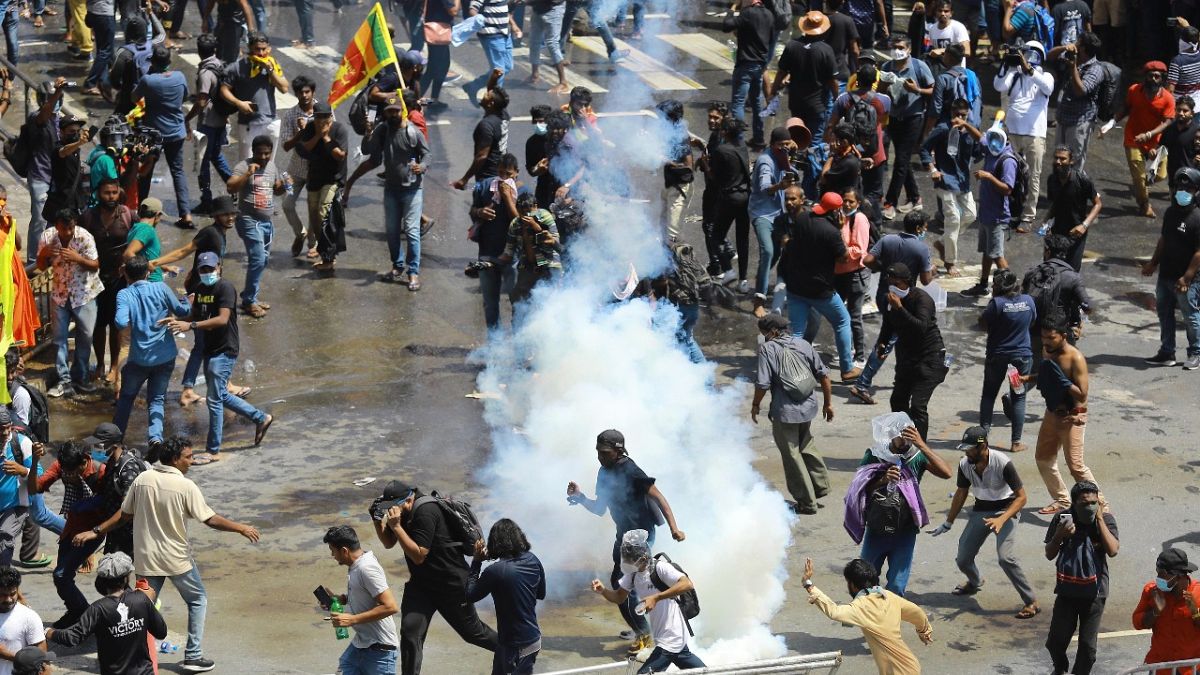Crowds stormed the president's home and office in Colombo on Saturday, and set the PM's home alight, amid anger over the worst economic crisis in decades.
The speaker of Sri Lanka’s Parliament says President Gotabaya Rajapaksa has agreed to resign as of Wednesday. It came after a dramatic day of protests over dire economic conditions that saw demonstrators break into his residency and office, and also set fire to the prime minister's house.
Mahinda Yapa Abeywardena said in a televised statement Saturday that he informed Rajapaksa of a decision taken at a meeting of Parliamentary party leaders requesting he leave office, and he agreed. However Rajapaksa will remain as president until Wednesday to ensure a smooth transfer of power.
Shortly earlier, protesters broke into the Sri Lankan prime minister's private residence and set it on fire, hours after he said he would resign when a new government is formed.
"Protesters broke into the private residence of Prime Minister Ranil Wickremesinghe and set it alight," the premier's office said on Saturday evening.
Saturday's angry demonstrations, the biggest so far, follow months of mounting public anger over the country's worst economic crisis in seven decades.
It wasn't immediately clear if Wickremesinghe, the prime minister, was inside his home at the time of the attack, but earlier in the day a source was quoted as saying he had been moved to a secure location.
Wickremesinghe said earlier that he will resign only when all parties have agreed on a new government. He was responding to a call by parliamentary party leaders for him to resign, along with President Gotabaya Rajapaksa.
Earlier in the day protesters, some holding Sri Lankan flags and helmets, broke into President Rajapaksa's residence. Videos posted on social media showed demonstrators moving around inside the palace and splashing around in a swimming pool.
Thousands of people had swarmed into Colombo's government district, shouting slogans against the president and dismantling several police barricades to reach Rajapaksa's house, a witness told Reuters.
Police fired shots in the air but were unable to stop the angry crowd from surrounding the presidential residence, the witness said.
TV footage also showed thousands of protesters breaking open the gates of the sea-front presidential secretariat, which has been the site of a sit-in protest for months, and entering the premises.
Military personnel and police at both locations were unable to hold back the crowd. Two defence ministry sources said President Rajapaksa was removed from the official residence on Friday for his safety ahead of the planned rally over the weekend.
Before protesters stormed his house too, Prime Minister Wickremesinghe summoned an emergency party leaders meeting on Saturday, his office said, and requested the speaker to summon parliament.
A Facebook livestream from inside the president's house showed hundreds of protesters, some draped in flags, packing into rooms and corridors, shouting slogans against Rajapaksa.
Hundreds also milled about on the grounds outside the colonial-era white-washed building. No security officials were visible.
At least 21 people, including two police were injured and hospitalised in the ongoing protests, hospital sources told Reuters.
Authorities have imposed a 9pm curfew in Colombo until further notice to counter the protests. However, opposition politicians have slammed the move as illegal.
The island of 22 million people is struggling under a severe foreign exchange shortage that has limited essential imports of fuel, food and medicine, plunging it into the worst economic crisis since independence in 1948.
The crisis comes after COVID-19 hammered the tourism-reliant economy and slashed remittances from overseas workers, and has been compounded by the build-up of huge government debt, rising oil prices and a ban on the import of chemical fertilisers last year that devastated agriculture.
Many blame the country's decline on President Rajapaksa. Largely peaceful protests since March have demanded his resignation.
Despite a severe shortage of fuel that has stalled transportation services, demonstrators packed into buses, trains and trucks from several parts of the country to reach Colombo to protest the government's failure to protect them from economic ruin.
Discontent has worsened in recent weeks as the cash-strapped country stopped receiving fuel shipments, forcing school closures and rationing of petrol and diesel for essential services.
